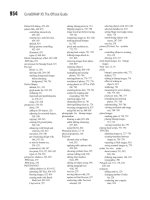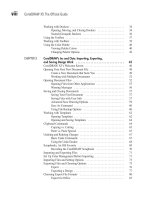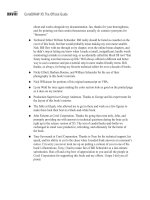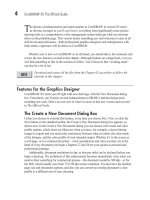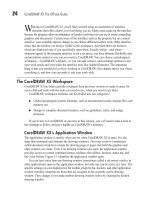CorelDRAW X5 The Official Guide part 57 docx
Bạn đang xem bản rút gọn của tài liệu. Xem và tải ngay bản đầy đủ của tài liệu tại đây (322.65 KB, 10 trang )
Loading and Creating Custom Palettes
Through dialogs, the Color docker, or an open Color Palette, you can manage your color
collections. The fastest way is to click the flyout arrow on a Color Palette and then to choose
Palette | Open from the pop-up menu. This displays the Open Palette dialog, where you can
browse what’s available. The pop-up menu also includes Save, Save As, Close, and New
palette commands.
The Palette Editor, shown in Figure 17-7, is the ideal place to rework custom palettes. In
this dialog you can create, save, edit, and manage new and existing palettes using convenient
command buttons. While editing palette colors, you can also access CorelDRAW’s other
color features.
Refining and redefining your palettes is easy, fun, and often necessary to keep palettes
for client colors up-to-date. Try these steps to appreciate the ease of this powerful dialog.
Editing Color Palettes
1. Open the Palette Editor; choose Tools | Palette Editor. Choose a palette by clicking
the drop-down selector; open the directory tree for Custom Palettes or User’s
Palettes; click a palette name to choose it.
2. To edit an existing palette color, click a color and then click Edit Color. The Select
Color dialog opens to offer color models, mixers, and palettes, exactly like the
Uniform Fill dialog.
524 CorelDRAW X5 The Official Guide
“Web Safe” Colors
Although the W3 Consortium publishes standards, you might feel a little confined
choosing from only 216 colors that are Web Safe. Web Safe, by definition, means that
these colors can be displayed accurately on a VGA monitor without color dithering, and
that the colors display somewhat consistently whether you have color management on
your computer turned on or off. Realistically, three people on earth still have a VGA
monitor and a video card with less than 10MB of RAM. Additionally, designers tend to
work with designers, and very few of us don’t run a color management system—color
management actually has been at the core of CorelDRAW and Windows since 1995.
There’s something commendable about “playing to the cheap seats,” but in
actuality, very few designers bother with Web Safe colors. Every day, millions of
people post JPEG images to the Web that look just fine, and these JPEGs decidedly
have colors that fall outside of Web Safe standards.
3. To begin a new palette, click the New Palette button in the Palette Editor dialog to
open the New Palette dialog. Enter a name and then click Save. Your new palette is
automatically opened, but there are no colors yet.
4. To add colors, click Add Color, which takes you to the Select Color dialog. Define
your new color—with the Mixers module, you can choose a whole color range in
one fell swoop—then click the Add To Palette button. New colors are immediately
added to your new palette.
5. Once your colors have been added, click OK to return to the Palette Editor dialog. In
the Name box, here’s where you get to name a new color. When you use the edited
color palette, the color name will appear on the status bar and in tooltips pop-ups
instead of the component values.
6. To remove a selected color, click Delete Color and confirm your action in the
prompt that appears. To reorganize your palette colors, click Sort Colors and then
choose from Reverse, Name, Hue, Brightness, Saturation, RGB Value, or HSB
Value. You can also click-drag a color well (color swatch) to reorder swatches as
they appear on the Color Palette.
CHAPTER 17: Digital Color Theory Put to Practice 525
17
FIGURE 17-7 Manage custom palettes in the Palette Editor.
Name
New Palette
Open Palette
Save Palette
Save Palette As
Edit Selected Color
Type the name
to appear.
7. To name or rename an existing color, select the color in the palette, highlight its
current name in the Name box, and then enter a new name. Existing names are
automatically overwritten once a new color is selected.
8. Use the Reset Palette button to restore your palette to its original state before any
changes were made, or click OK to accept your changes and close the dialog.
Now that you know how to create, save, and load color palettes, take a look at
Russel Wright.xml. This palette was created by sampling photos of some of the art
of historic ceramicist Russel Wright, whose work was exalted as modernist in the
1930s and 1940s. It’s a nice, small, named palette for use when you need a truly
retro look to a design.
There’s one more way to make and save a user-defined palette: if you like the color of
objects you have on the page, choose Window | Color Palettes | Create Palette From
Selection (if you have objects selected in advance), or Create Palette From Document. This
opens the Save Palette dialog, where you can name and save the colors you’ve used as a
unique palette.
You can quickly copy color properties between two objects (including groups) by
right-click-dragging an object on top of a different object. Release the mouse button
once the source object is in position, and then choose Copy Fill Here or Copy
Outline Here.
Color and Color Correction
Without defining a master color, creating relationships between parent and child colors, and
without getting elaborate, you have another way to change colors in a CorelDRAW design.
The Effects | Adjust menu has color and tone (brightness) corrections you can apply to an
object—vector or bitmap—so you can modify all or parts of a design, and thus create variations
on copies of your work. These changes are permanent; you should use the commands only on
copies of your illustrations, or have the Window | Dockers | Undo docker handy in the
workspace. These effects are mutually exclusive, and depending on the color solution you
seek, you might need to apply one, and then a different one.
Be sure every time you use the effects commands to click Reset. All command
palettes remember your last used settings.
●
Brightness/Contrast/Intensity This command displays a palette where you can
compress or expand the range of tones between the lightest and darkest (Contrast),
add or subtract illumination from the selected object (Brightness), and use Intensity
as an inverse operator to Brightness to make an object’s colors more pronounced—
decrease Brightness and then increase Intensity to see a working example of
Intensity.
526 CorelDRAW X5 The Official Guide
●
Color Balance Cyan is the additive color opposite of red, magenta’s the opposite
of green, and yellow is the color opposite of blue. Use this command palette to
remove color casting in your selection in the three different tone areas. For example,
the Compass.cdr file you’ll experiment with shortly has a lot of deep reds toward the
top of the grouped objects. Suppose you want to cool down only the deep reds, but
not the medium reds. You put a check in the Shadows Range box, and then drag the
Cyan-Red slider toward Cyan. Preserve Luminosity is an option when you want to
shift the color in the selected object without changing its brightness. Color is linked
to brightness, as you’ll observe when using the HSV color model; when you change
hue, you frequently also change brightness.
●
Gamma In video electronics, there is a “sag” (a non-linearity) when plotting
signal to brightness; it’s a physical drop-off that visually affects the midtones in
images and designs you work with. The relationship between brightness and signal
is called gamma, and the practical (nontechnical) purpose for gamma adjustment is
to open up or block in midtones in a selected graphic or photo without impact on the
lightest and darkest points in the brightnesses. Drag the Gamma slider to the right to
increase the range of midtones, and drag it left to compress the midtone range.
●
Hue/Saturation/Lightness Use this command palette to shift certain hues to
different ones, increase or decrease the richness of hues, and to increase or decrease
the amount of white in the selection.
When you use any of the preceding commands, a pop-up menu offers the other Effects menu
items. If you’ve selected a bitmap, you can use any and all of the commands, but if you have
a vector object selected, most commands are unavailable, except two:
●
Invert This is a one-pop command with no options or command palette. It
chromatically reverses color and tone areas. For example, deep red areas become
light cyan.
●
Posterize This command has one slider marked “Levels.” From a minimum of 2 to
a maximum of 23, this effect moves all the colors in the selected object to a small,
fixed range of colors. Although its use is perhaps best with photographs that you
want to make look like rubber-stamp art or a silk-screened poster, objects with
fountain fills and full-color pattern fills can take on an interesting look, too.
Posterize and Invert are both under the Effects | Transform menu.
There is no “right” or “wrong” goal in the following steps: the intention here is simply to
get you comfortable with adjusting colors in a composition by using the Effects menu. Open
Compass.cdr now, and let’s say a client wants a brighter, lighter version of this drawing, and
you didn’t create master colors, and the darned thing has over 80 objects you’d have to
recolor…
CHAPTER 17: Digital Color Theory Put to Practice 527
17
Changing Colors with Effects
1. Duplicate the illustration first and then move it to one side so you can compare your
results with the original.
2. Choose Windows | Docker | Undo, so you can undo any effect at any time.
3. With the copy selected, choose Effects | Adjust | Brightness/Contrast/Intensity.
4. Click Reset, as a matter of practice. Drag the Contrast slider to about 25, and then
click Preview. Hmm, the colors are more pronounced, but not lighter, so half the
request is addressed.
5. Drag the Intensity slider to about 35 and then click Preview. The graphic is
improved, but the colors might need some saturation. Click OK to apply this effect.
6. Choose Effects | Adjust | Hue/Saturation/Lightness. Click Reset.
7. Click the Red channel button to correct only the predominantly red areas of the
graphic.
8. Drag the Saturation slider to about 45 and then click Preview. Hmmm, better, but the
red is now too light.
9. Drag the Lightness slider to –7 and then click Preview. Compare the graphic to its
duplicate. For this example, let’s consider the job well done—it’s a much lighter,
more lively graphic now, as you can sort of see in Figure 17-8. Click OK to apply
the filter.
10. The phone rings, it’s the client, and they decide they like the original. On the Undo
docker, click Duplicate to send the original back in steps to before you applied any
adjustments. Sure, you could delete the original and use the duplicate, but then you
wouldn’t have learned how to use the Undo docker to save time! Charge the client
extra for the time they don’t know you saved on revisions.
You’ve seen in this chapter that color is important; color sets a mood for an illustration,
and the artistic use of color can actually remedy an illustration that lacks visual interest or
complexity. And you now know how to define and save not only a color you need, but also
an entire palette. This concludes the section on colors and fills. From here we travel to the
land of very special effects—take what you’ve learned, take what you’ve drawn, and bend it,
distort it, and in general, make it a unique piece by learning how to sculpt vector shapes.
528 CorelDRAW X5 The Official Guide
CHAPTER 17: Digital Color Theory Put to Practice 529
17
FIGURE 17-8 Change the colors of grouped objects selectively with the Effects | Adjust
commands.
This page intentionally left blank
PART VI
Creating the Illusion of
3D Objects
This page intentionally left blank
CHAPTER 18
Working with
Perspective
533
